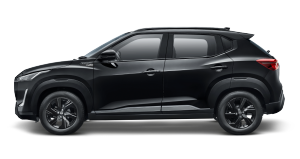Switch to the Future
Nissan’s cars are evolving. From their driving performance to their fuel consumption, the engines to the brakes. Even the switches and dials.

THE AIM IS TO FIND AN INTERFACE THAT IS UNIVERSAL AND EASY TO USE FOR ALL DRIVERS.

The large-scale driving simulator can recreate the conditions of driving on a highway. It uses a real car that can be “driven” using the pedals, while in front and behind there is a massive screen with a computer graphic landscape.

The easy-to-use dial on the car navigation system is an example of an interface perfected from tests with the driving simulator. To control the device, drivers press the eight buttons, twist the dial, and also touch the screen.

One of the many things tested with the driving simulator are the controls and switches for the steering wheel, which are all designed ergonomically.
The evolutionists constantly investigating and advancing the controls in a Nissan vehicle are the Human Engineering Team. It’s their mission to enhance the safety, handling and cognitive properties for all the things that drivers touch in their cars. Naturally, demonstration tests inside a moving vehicle are imperative for this. However, there is a reason why testing responses while actually driving is tricky: It’s just not safe.
The solution is the driving simulator. Nissan designs and adjusts switches and dials to the centimeter so it needs a large-scale device to test things out. This simulator creates a driving “performance” just like the real thing. Sitting in the cockpit, a giant screen in front and behind shows computer graphics that match the simulated driving motion. The test participant truly comes to believe they are actually driving on a road. When asked to crash into another “car” driving alongside them in the simulation, they apparently answer that they are too scared to try! The driving simulator’s secret to its success lies in the use of a video screen that appears 3D and in deftly recreating the effects of g-force on the test participant.
The simulator records a driver’s brain waves, and the way he or she looks at and uses all the devices inside the car: Dials, switches, buttons, meters, car navigation, audio equipment, air conditioning, the steering. From this the Human Engineering Team works out guidelines for the sizes and numbers of things in the vehicle, passing on this feedback to the design and planning departments. Of course, the test participants are not just drawn from the ranks of the ergonomics specialists themselves, but from regular members of the public as well, and in variations of gender, age and driving experience. The aim is to find an interface that is universal and easy to use for all drivers.
One example of something that has evolved through ergonomic testing with the driving simulator is the car navigation system, which integrates dials and buttons with a touchscreen. Drivers select what they want from the eight buttons, or use the touch panel interface or central rotating dial. Even when driving they don’t have to read the screen since they intuitively come to learn the controls through the physical feel of turning the dial. They can also operate the device through switches on the steering wheel. Combining a touchscreen with these kinds of switches and dials gives birth to an intuitive but safe interface.
Yonosuke Miki is Human Engineering Team Manager, in charge of harnessing the driving simulator to improve Nissan’s vehicles. Developing a car interface is special, he says. “Out of all the forms of mobility in the world – planes, ships – what is difficult for a car is that an unspecified number of people will use it daily.” Unlike pilots, who are trained, the controls of a car are operated by ordinary drivers, just normal people, so it’s vital to make an interface that is universal, safe, and user-friendly. And this is why at Nissan even the smallest switch in a car is also always evolving.



